ESP FIAT SCUDO 2013 Owner handbook (in English)
[x] Cancel search | Manufacturer: FIAT, Model Year: 2013, Model line: SCUDO, Model: FIAT SCUDO 2013Pages: 223, PDF Size: 9.76 MB
Page 105 of 223
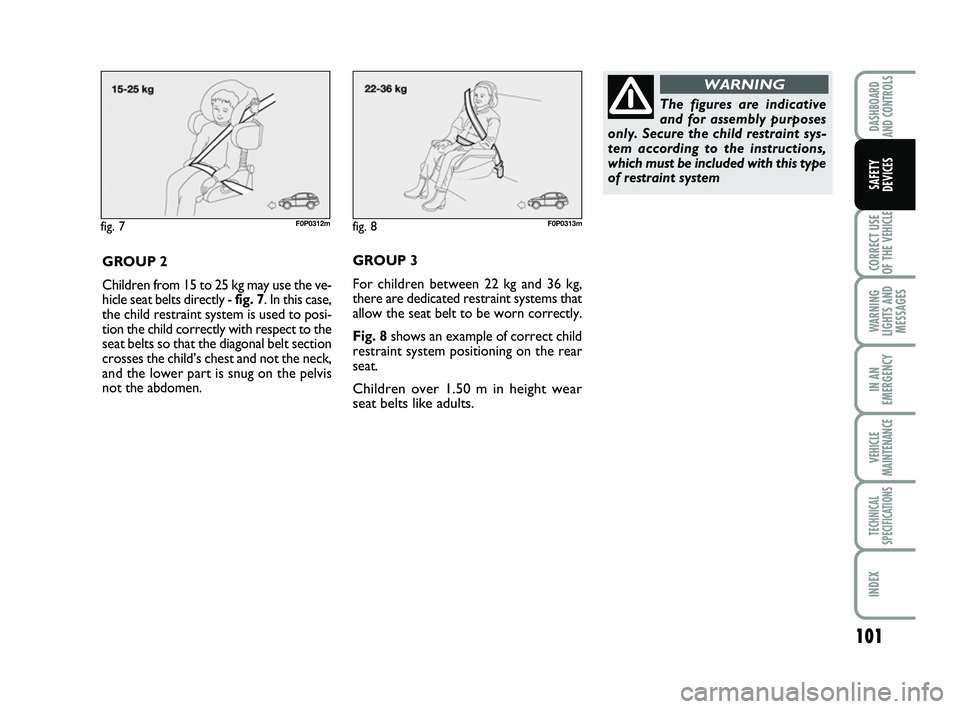
101
CORRECT USE
OF THE
VEHICLE
WARNING
LIGHTS AND
MESSAGES
IN AN
EMERGENCY
VEHICLE
MAINTENANCE
TECHNICAL
SPECIFICATIONS
INDEX
DASHBOARD
AND CONTROLS
SAFETY
DEVICES
fig. 7F0P0312m
GROUP 2
Children from 15 to 25 kg may use the ve-
hicle seat belts directly - fig. 7. In this case,
the child restraint system is used to posi-
tion the child correctly with respect to the
seat belts so that the diagonal belt section
crosses the child’s chest and not the neck,
and the lower part is snug on the pelvis
not the abdomen.
The figures are indicative
and for assembly purposes
only. Secure the child restraint sys-
tem according to the instructions,
which must be included with this type
of restraint system
WARNING
GROUP 3
For children between 22 kg and 36 kg,
there are dedicated restraint systems that
allow the seat belt to be worn correctly.
Fig. 8shows an example of correct child
restraint system positioning on the rear
seat.
Children over 1.50 m in height wear
seat belts like adults.
fig. 8F0P0313m
093-112 SCUDO LUM GB 9-10-2012 15:48 Pagina 101
Page 112 of 223
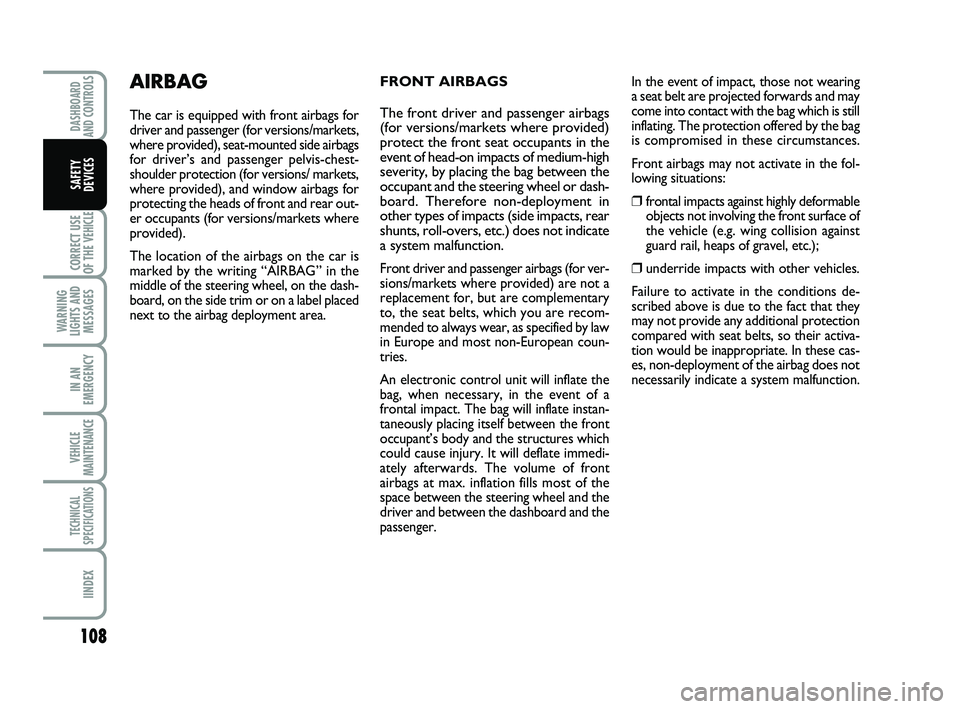
108
CORRECT USE OF THE
VEHICLE
WARNING LIGHTS ANDMESSAGES
IN AN EMERGENCY
VEHICLE MAINTENANCE
TECHNICAL SPECIFICATIONS
IINDEX
DASHBOARD AND CONTROLS
SAFETY DEVICES
FRONT AIRBAGS
The front driver and passenger airbags (for versions/markets where provided)protect the front seat occupants in theevent of head-on impacts of medium-highseverity, by placing the bag between theoccupant and the steering wheel or dash-board. Therefore non-deployment inother types of impacts (side impacts, rearshunts, roll-overs, etc.) does not indicatea system malfunction.
Front driver and passenger airbags (for ver-sions/markets where provided) are not areplacement for, but are complementaryto, the seat belts, which you are recom-mended to always wear, as specified by lawin Europe and most non-European coun-tries.
An electronic control unit will inflate the bag, when necessary, in the event of afrontal impact. The bag will inflate instan-taneously placing itself between the frontoccupant’s body and the structures whichcould cause injury. It will deflate immedi-ately afterwards. The volume of frontairbags at max. inflation fills most of thespace between the steering wheel and thedriver and between the dashboard and thepassenger.
AIRBAG
The car is equipped with front airbags fordriver and passenger (for versions/markets,where provided), seat-mounted side airbagsfor driver’s and passenger pelvis-chest-shoulder protection (for versions/ markets,where provided), and window airbags forprotecting the heads of front and rear out-er occupants (for versions/markets whereprovided).
The location of the airbags on the car is marked by the writing “AIRBAG” in themiddle of the steering wheel, on the dash-board, on the side trim or on a label placednext to the airbag deployment area.
In the event of impact, those not wearing a seat belt are projected forwards and maycome into contact with the bag which is stillinflating. The protection offered by the bagis compromised in these circumstances.
Front airbags may not activate in the fol- lowing situations:
❒frontal impacts against highly deformableobjects not involving the front surface ofthe vehicle (e.g. wing collision againstguard rail, heaps of gravel, etc.);
❒underride impacts with other vehicles
Failure to activate in the conditions de- scribed above is due to the fact that theymay not provide any additional protection
compared with seat belts, so their activa-tion would be inappropriate. In these cas-es, non-deployment of the airbag does notnecessarily indicate a system malfunction.
093-112 SCUDO LUM GB 9-10-2012 15:48 Pagina 108
.
Page 120 of 223
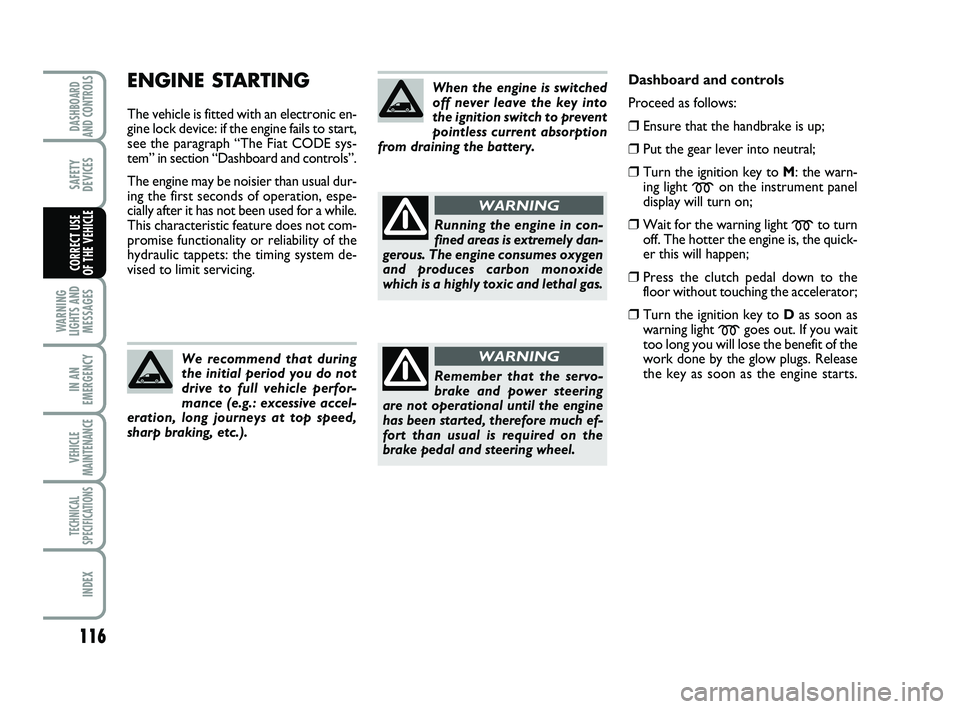
116
WARNING
LIGHTS AND
MESSAGES
IN AN
EMERGENCY
VEHICLE
MAINTENANCE
TECHNICAL
SPECIFICATIONS
INDEX
DASHBOARD
AND CONTROLS
SAFETY
DEVICES
CORRECT USE
OF THE VEHICLE
ENGINE STARTING
The vehicle is fitted with an electronic en-
gine lock device: if the engine fails to start,
see the paragraph “The Fiat CODE sys-
tem” in section “Dashboard and controls”.
The engine may be noisier than usual dur-
ing the first seconds of operation, espe-
cially after it has not been used for a while.
This characteristic feature does not com-
promise functionality or reliability of the
hydraulic tappets: the timing system de-
vised to limit servicing.
We recommend that during
the initial period you do not
drive to full vehicle perfor-
mance (e.g.: excessive accel-
eration, long journeys at top speed,
sharp braking, etc.).
When the engine is switched
off never leave the key into
the ignition switch to prevent
pointless current absorption
from draining the battery.
Running the engine in con-
fined areas is extremely dan-
gerous. The engine consumes oxygen
and produces carbon monoxide
which is a highly toxic and lethal gas.
WARNING
Remember that the servo-
brake and power steering
are not operational until the engine
has been started, therefore much ef-
fort than usual is required on the
brake pedal and steering wheel.
WARNING
Dashboard and controls
Proceed as follows:
❒Ensure that the handbrake is up;
❒Put the gear lever into neutral;
❒Turn the ignition key to M: the warn-
ing light
mon the instrument panel
display will turn on;
❒Wait for the warning light mto turn
off. The hotter the engine is, the quick-
er this will happen;
❒Press the clutch pedal down to the
floor without touching the accelerator;
❒Turn the ignition key to Das soon as
warning light
mgoes out. If you wait
too long you will lose the benefit of the
work done by the glow plugs. Release
the key as soon as the engine starts.
115-124 SCUDO LUM GB_113-122 Nuovo ScudoG9 GB 17/10/12 14.41 Pagina 116
Page 121 of 223
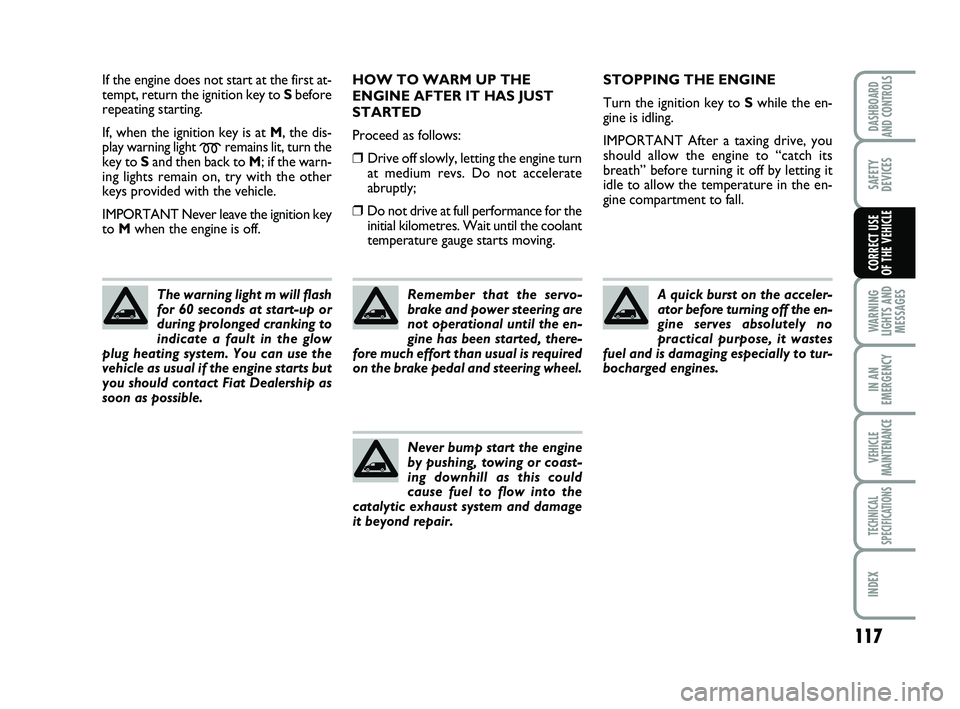
117
WARNING
LIGHTS AND
MESSAGES
IN AN
EMERGENCY
VEHICLE
MAINTENANCE
TECHNICAL
SPECIFICATIONS
INDEX
DASHBOARD
AND CONTROLS
SAFETY
DEVICES
CORRECT USE
OF THE VEHICLE
If the engine does not start at the first at-
tempt, return the ignition key to Sbefore
repeating starting.
If, when the ignition key is at M, the dis-
play warning light
mremains lit, turn the
key to Sand then back to M; if the warn-
ing lights remain on, try with the other
keys provided with the vehicle.
IMPORTANT Never leave the ignition key
to Mwhen the engine is off.
The warning light m will flash
for 60 seconds at start-up or
during prolonged cranking to
indicate a fault in the glow
plug heating system. You can use the
vehicle as usual if the engine starts but
you should contact Fiat Dealership as
soon as possible.
HOW TO WARM UP THE
ENGINE AFTER IT HAS JUST
STARTED
Proceed as follows:
❒Drive off slowly, letting the engine turn
at medium revs. Do not accelerate
abruptly;
❒Do not drive at full performance for the
initial kilometres. Wait until the coolant
temperature gauge starts moving.
Remember that the servo-
brake and power steering are
not operational until the en-
gine has been started, there-
fore much effort than usual is required
on the brake pedal and steering wheel.
Never bump start the engine
by pushing, towing or coast-
ing downhill as this could
cause fuel to flow into the
catalytic exhaust system and damage
it beyond repair.
STOPPING THE ENGINE
Turn the ignition key to Swhile the en-
gine is idling.
IMPORTANT After a taxing drive, you
should allow the engine to “catch its
breath” before turning it off by letting it
idle to allow the temperature in the en-
gine compartment to fall.
A quick burst on the acceler-
ator before turning off the en-
gine serves absolutely no
practical purpose, it wastes
fuel and is damaging especially to tur-
bocharged engines.
115-124 SCUDO LUM GB_113-122 Nuovo ScudoG9 GB 17/10/12 14.41 Pagina 117
Page 129 of 223
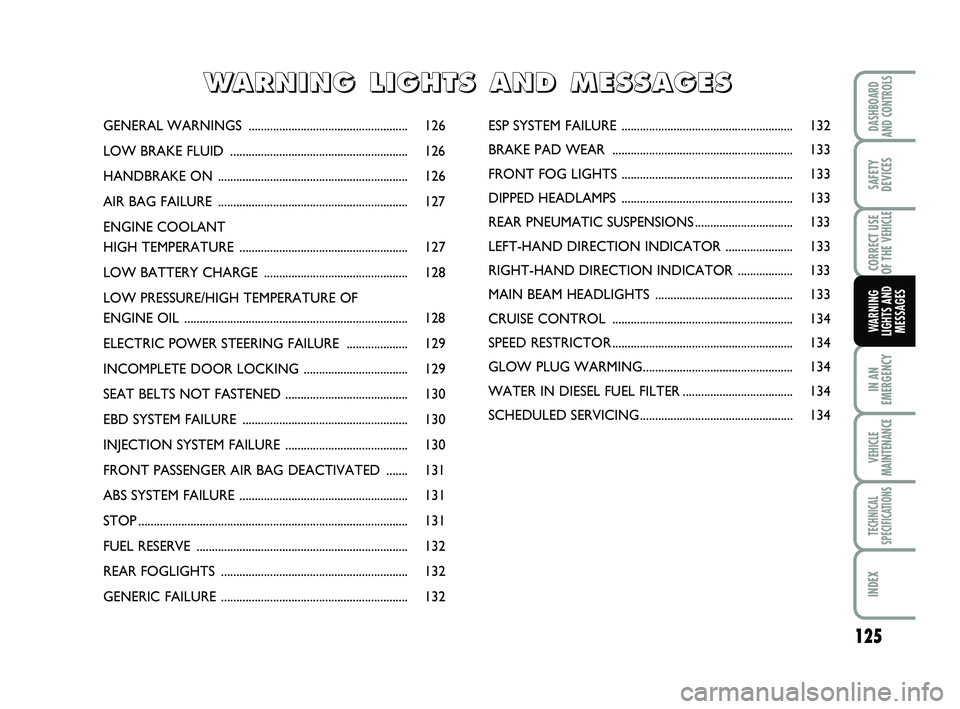
125
IN AN EMERGENCY
VEHICLE MAINTENANCE
TECHNICAL SPECIFICATIONS
INDEX
DASHBOARD AND CONTROLS
SAFETY DEVICES
CORRECT USE OF THE
VEHICLE
WARNINGLIGHTS ANDMESSAGES
GENERAL WARNINGS .................................................... 126
LOW BRAKE FLUID .......................................................... 126
HANDBRAKE ON .............................................................. 126
AIR BAG FAILURE .............................................................. 127
ENGINE COOLANT
HIGH TEMPERATURE ....................................................... 127
LOW BATTERY CHARGE ............................................... 128
LOW PRESSURE/HIGH TEMPERATURE OF
ENGINE OIL ......................................................................... 128
ELECTRIC POWER STEERING FAILURE .................... 129
INCOMPLETE DOOR LOCKING .................................. 129
SEAT BELTS NOT FASTENED ........................................ 130
EBD SYSTEM FAILURE ...................................................... 130
INJECTION SYSTEM FAILURE ........................................130
FRONT PASSENGER AIR BAG DEACTIVATED ....... 131
ABS SYSTEM FAILURE ....................................................... 131
STOP ........................................................................................ 131
FUEL RESERVE ..................................................................... 132
REAR FOGLIGHTS ............................................................. 132
GENERIC FAILURE .............................................................13
ESP SYSTEM FAILURE ........................................................ 132
BRAKE PAD WEAR ........................................................... 133
FRONT FOG LIGHTS ........................................................ 133
DIPPED HEADLAMPS ........................................................ 133
REAR PNEUMATIC SUSPENSIONS ................................ 133
LEFT-HAND DIRECTION INDICATOR ...................... 133
RIGHT-HAND DIRECTION INDICATOR .................. 133
MAIN BEAM HEADLIGHTS ............................................. 133
CRUISE CONTROL ........................................................... 134
SPEED RESTRICTOR ........................................................... 134
GLOW PLUG WARMING................................................. 134
WATER IN DIESEL FUEL FILTER .................................... 134
SCHEDULED SERVICING..................................................13
W W A A R R N N I I N N G G L L I I G G H H T T S S A A N N D D M M E E S S S S A A G G E E S S
125-134 SCUDO LUM GB_123-132 Nuovo ScudoG9 GB 17/10/12 14.42 Pagina 125
2
4
Page 136 of 223
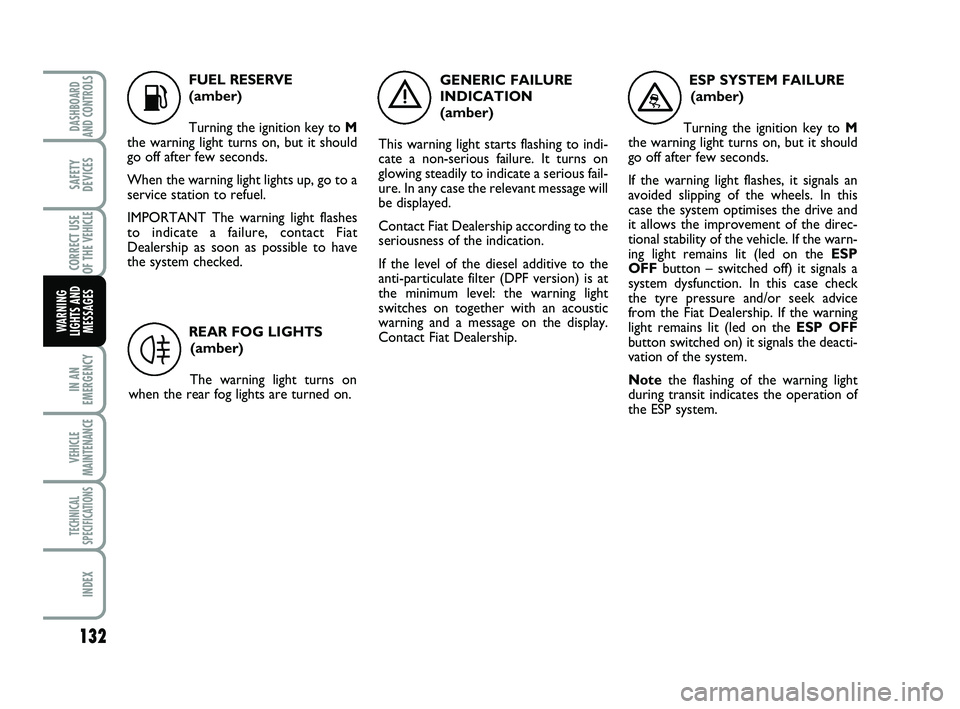
132
IN AN
EMERGENCY
VEHICLE
MAINTENANCE
TECHNICAL
SPECIFICATIONS
INDEX
DASHBOARD
AND CONTROLS
SAFETY
DEVICES
CORRECT USE
OF THE
VEHICLE
WARNING
LIGHTS AND
MESSAGES
K
FUEL RESERVE
(amber)
Turning the ignition key to M
the warning light turns on, but it should
go off after few seconds.
When the warning light lights up, go to a
service station to refuel.
IMPORTANT The warning light flashes
to indicate a failure, contact Fiat
Dealership as soon as possible to have
the system checked.
REAR FOG LIGHTS
(amber)
The warning light turns on
when the rear fog lights are turned on.
4
GENERIC FAILURE
INDICATION
(amber)
This warning light starts flashing to indi-
cate a non-serious failure. It turns on
glowing steadily to indicate a serious fail-
ure. In any case the relevant message will
be displayed.
Contact Fiat Dealership according to the
seriousness of the indication.
If the level of the diesel additive to the
anti-particulate filter (DPF version) is at
the minimum level: the warning light
switches on together with an acoustic
warning and a message on the display.
Contact Fiat Dealership.
è
ESP SYSTEM FAILURE
(amber)
Turning the ignition key to M
the warning light turns on, but it should
go off after few seconds.
If the warning light flashes, it signals an
avoided slipping of the wheels. In this
case the system optimises the drive and
it allows the improvement of the direc-
tional stability of the vehicle. If the warn-
ing light remains lit (led on the ESP
OFFbutton – switched off) it signals a
system dysfunction. In this case check
the tyre pressure and/or seek advice
from the Fiat Dealership. If the warning
light remains lit (led on the ESP OFF
button switched on) it signals the deacti-
vation of the system.
Notethe flashing of the warning light
during transit indicates the operation of
the ESP system.
™
125-134 SCUDO LUM GB_123-132 Nuovo ScudoG9 GB 17/10/12 14.42 Pagina 132
Page 141 of 223
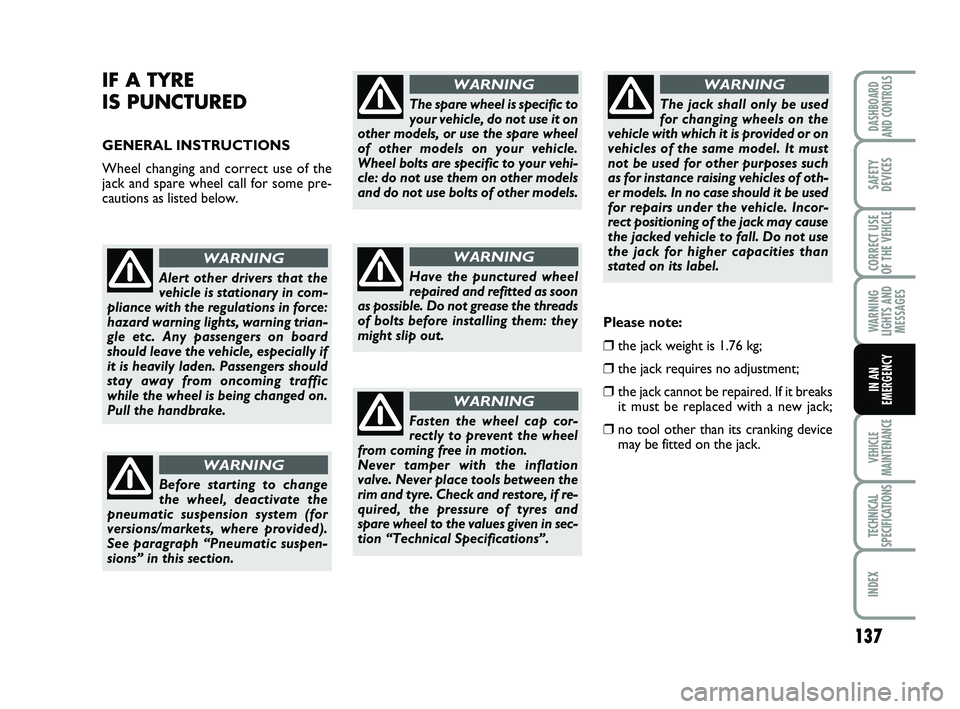
137
WARNING
LIGHTS AND
MESSAGES
VEHICLE
MAINTENANCE
TECHNICAL
SPECIFICATIONS
INDEX
DASHBOARD
AND CONTROLS
SAFETY
DEVICES
CORRECT USE
OF THE
VEHICLE
IN AN
EMERGENCY
IF A TYRE
IS PUNCTURED
GENERAL INSTRUCTIONS
Wheel changing and correct use of the
jack and spare wheel call for some pre-
cautions as listed below.
Alert other drivers that the
vehicle is stationary in com-
pliance with the regulations in force:
hazard warning lights, warning trian-
gle etc. Any passengers on board
should leave the vehicle, especially if
it is heavily laden. Passengers should
stay away from oncoming traffic
while the wheel is being changed on.
Pull the handbrake.
WARNING
Before starting to change
the wheel, deactivate the
pneumatic suspension system (for
versions/markets, where provided).
See paragraph “Pneumatic suspen-
sions” in this section.
WARNING
The spare wheel is specific to
your vehicle, do not use it on
other models, or use the spare wheel
of other models on your vehicle.
Wheel bolts are specific to your vehi-
cle: do not use them on other models
and do not use bolts of other models.
WARNING
Have the punctured wheel
repaired and refitted as soon
as possible. Do not grease the threads
of bolts before installing them: they
might slip out.
WARNING
The jack shall only be used
for changing wheels on the
vehicle with which it is provided or on
vehicles of the same model. It must
not be used for other purposes such
as for instance raising vehicles of oth-
er models. In no case should it be used
for repairs under the vehicle. Incor-
rect positioning of the jack may cause
the jacked vehicle to fall. Do not use
the jack for higher capacities than
stated on its label.
WARNING
Fasten the wheel cap cor-
rectly to prevent the wheel
from coming free in motion.
Never tamper with the inflation
valve. Never place tools between the
rim and tyre. Check and restore, if re-
quired, the pressure of tyres and
spare wheel to the values given in sec-
tion “Technical Specifications”.
WARNING
Please note:
❒ the jack weight is 1.76 kg;
❒ the jack requires no adjustment;
❒ the jack cannot be repaired. If it breaks
it must be replaced with a new jack;
❒ no tool other than its cranking device
may be fitted on the jack.
135-154 SCUDO LUM GB_133-152 Nuovo ScudoG9 GB 17/10/12 14.43 Pagina 137
Page 145 of 223
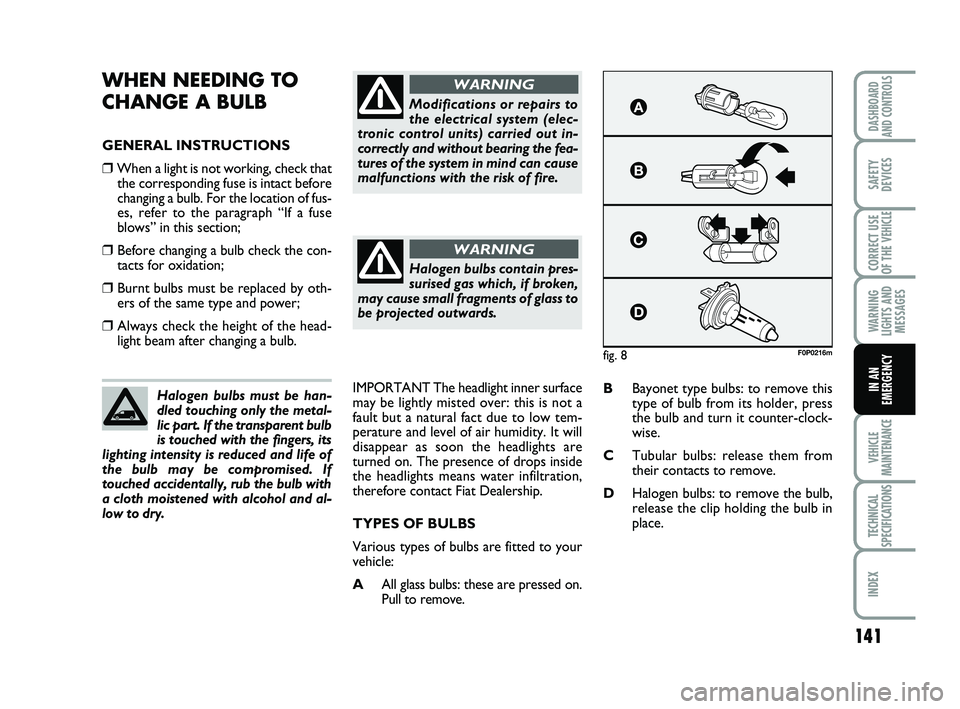
141
WARNING
LIGHTS AND
MESSAGES
VEHICLE
MAINTENANCE
TECHNICAL
SPECIFICATIONS
INDEX
DASHBOARD
AND CONTROLS
SAFETY
DEVICES
CORRECT USE
OF THE
VEHICLE
IN AN
EMERGENCY
WHEN NEEDING TO
CHANGE A BULB
GENERAL INSTRUCTIONS
❒When a light is not working, check that
the corresponding fuse is intact before
changing a bulb. For the location of fus-
es, refer to the paragraph “If a fuse
blows” in this section;
❒ Before changing a bulb check the con-
tacts for oxidation;
❒ Burnt bulbs must be replaced by oth-
ers of the same type and power;
❒ Always check the height of the head-
light beam after changing a bulb.
IMPORTANT The headlight inner surface
may be lightly misted over: this is not a
fault but a natural fact due to low tem-
perature and level of air humidity. It will
disappear as soon the headlights are
turned on. The presence of drops inside
the headlights means water infiltration,
therefore contact Fiat Dealership.
TYPES OF BULBS
Various types of bulbs are fitted to your
vehicle:
AAll glass bulbs: these are pressed on.
Pull to remove.BBayonet type bulbs: to remove this
type of bulb from its holder, press
the bulb and turn it counter-clock-
wise.
CTubular bulbs: release them from
their contacts to remove.
DHalogen bulbs: to remove the bulb,
release the clip holding the bulb in
place. Halogen bulbs must be han-
dled touching only the metal-
lic part. If the transparent bulb
is touched with the fingers, its
lighting intensity is reduced and life of
the bulb may be compromised. If
touched accidentally, rub the bulb with
a cloth moistened with alcohol and al-
low to dry.
Modifications or repairs to
the electrical system (elec-
tronic control units) carried out in-
correctly and without bearing the fea-
tures of the system in mind can cause
malfunctions with the risk of fire.
WARNING
Halogen bulbs contain pres-
surised gas which, if broken,
may cause small fragments of glass to
be projected outwards.
WARNING
fig. 8F0P0216m
135-154 SCUDO LUM GB_133-152 Nuovo ScudoG9 GB 17/10/12 14.43 Pagina 141
Page 153 of 223
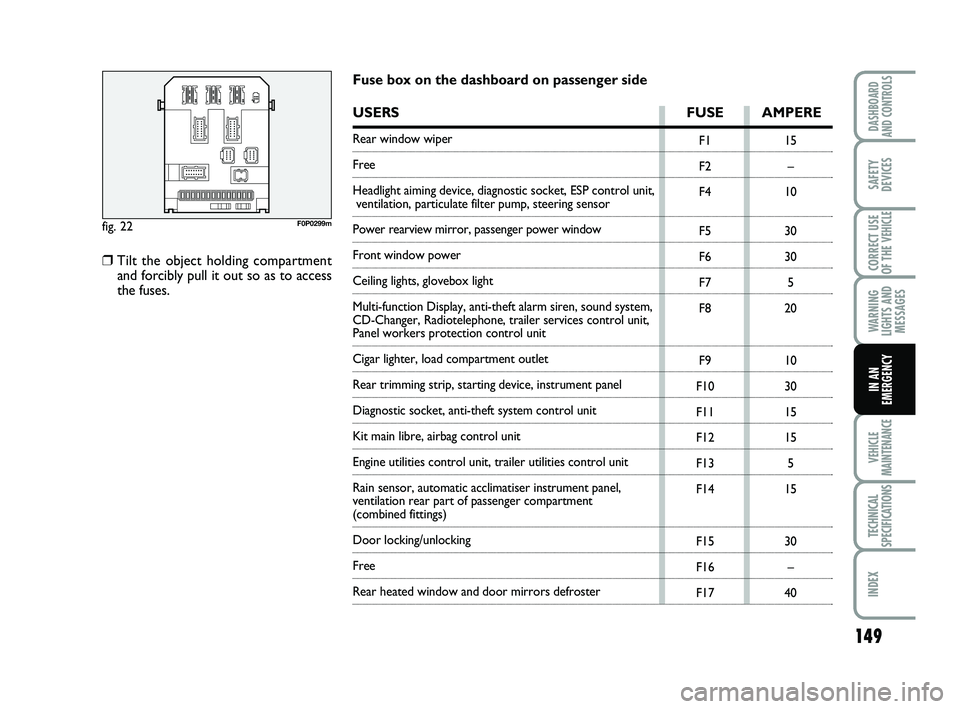
149
WARNING
LIGHTS AND
MESSAGES
VEHICLE
MAINTENANCE
TECHNICAL
SPECIFICATIONS
INDEX
DASHBOARD
AND CONTROLS
SAFETY
DEVICES
CORRECT USE
OF THE
VEHICLE
IN AN
EMERGENCY
fig. 22F0P0299m
F1
F2
F4
F5
F6
F7
F8
F9
F10
F11
F12
F13
F14
F15
F16
F1715
–
10
30
30
5
20
10
30
15
15
5
15
30
–
40
Fuse box on the dashboard on passenger side
USERS FUSE AMPERE
Rear window wiper
Free
Headlight aiming device, diagnostic socket, ESP control unit,
ventilation, particulate filter pump, steering sensor
Power rearview mirror, passenger power window
Front window power
Ceiling lights, glovebox light
Multi-function Display, anti-theft alarm siren, sound system,
CD-Changer, Radiotelephone, trailer services control unit,
Panel workers protection control unit
Cigar lighter, load compartment outlet
Rear trimming strip, starting device, instrument panel
Diagnostic socket, anti-theft system control unit
Kit main libre, airbag control unit
Engine utilities control unit, trailer utilities control unit
Rain sensor, automatic acclimatiser instrument panel,
ventilation rear part of passenger compartment
(combined fittings)
Door locking/unlocking
Free
Rear heated window and door mirrors defroster
❒Tilt the object holding compartment
and forcibly pull it out so as to access
the fuses.
135-154 SCUDO LUM GB_133-152 Nuovo ScudoG9 GB 17/10/12 14.43 Pagina 149
Page 166 of 223
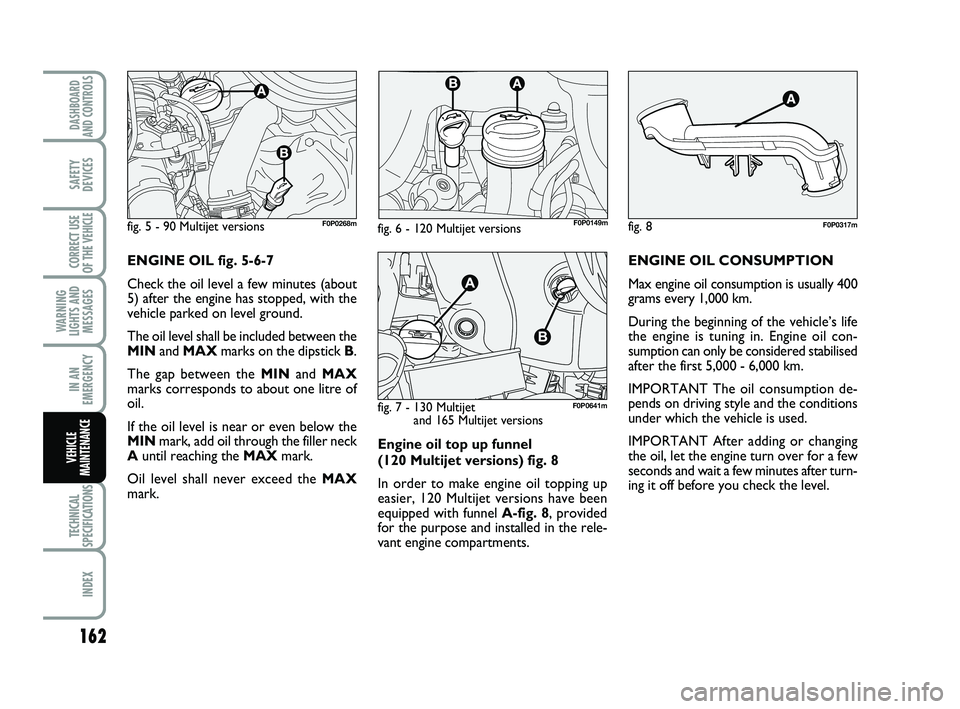
Engine oil top up funnel
(120 Multijet versions) fig. 8
In order to make engine oil topping up
easier, 120 Multijet versions have been
equipped with funnel A-fig. 8, provided
for the purpose and installed in the rele-
vant engine compartments.ENGINE OIL CONSUMPTION
Max engine oil consumption is usually 400
grams every 1,000 km.
During the beginning of the vehicle’s life
the engine is tuning in. Engine oil con-
sumption can only be considered stabilised
after the first 5,000 - 6,000 km.
IMPORTANT The oil consumption de-
pends on driving style and the conditions
under which the vehicle is used.
IMPORTANT After adding or changing
the oil, let the engine turn over for a few
seconds and wait a few minutes after turn-
ing it off before you check the level. ENGINE OIL fig. 5-6-7
Check the oil level a few minutes (about
5) after the engine has stopped, with the
vehicle parked on level ground.
The oil level shall be included between the
MINand MAXmarks on the dipstick B.
The gap between the MINand MAX
marks corresponds to about one litre of
oil.
If the oil level is near or even below the
MINmark, add oil through the filler neck
Auntil reaching the MAXmark.
Oil level shall never exceed the MAX
mark.
fig. 5 - 90 Multijet versionsF0P0268mF0P0149m
162
WARNING
LIGHTS AND
MESSAGES
TECHNICAL
SPECIFICATIONS
INDEX
DASHBOARD
AND CONTROLS
SAFETY
DEVICES
CORRECT USE
OF THE
VEHICLE
IN AN
EMERGENCY
VEHICLE
MAINTENANCE
fig. 6 - 120 Multijet versionsfig. 8F0P0317m
fig. 7 - 130 Multijet
and 165 Multijet versionsF0P0641m
155-174 SCUDO LUM GB_153-172 Nuovo ScudoG9 GB 17/10/12 14.44 Pagina 162